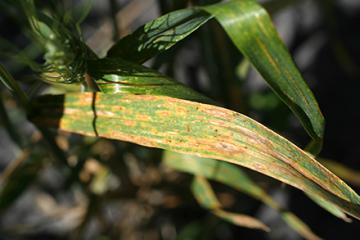Researchers ID Pathogenic Agent that Tricks Plant’s Defenses
Scientists with USDA’s Agricultural Research Service (ARS) have discovered wheat genes that, in essence, allow a pathogen to con a wheat plant into self-annihilation.
Most plants contain resistance genes that recognize pathogens and protect plants from developing disease. However, geneticist Justin Faris and plant pathologist Tim Friesen, at the ARS Edward T. Schafer Agricultural Research Center, in Fargo, ND, have discovered a fungal pathogen that completely turns the tables on plants and their attempts to mount resistance. The pathogen, known as a necrotroph, has developed a way to hijack the wheat plant’s resistance response, causing a disease called septoria nodorum blotch (SNB).
Normally, a plant will defend itself from a pathogen by deliberately killing the cells surrounding that pathogen, essentially starving the disease because most pathogens feed on live cells. However, necrotrophs work in the opposite way – they thrive on dead cells. So, when plants deploy their natural response, they actually give the disease more to feed on, which causes the disease to spread. Eventually, the plant dies trying to save itself.
“We discovered a gene (Snn3-D1) that recognizes a specific molecule produced by the (necrotrophic) SNB pathogen,” Faris explained. “Thinking it needs to mount a defense response, it activates the ‘combat troops’ in the plant, not realizing that is exactly what the pathogen wants. Therefore, the pathogen tricks Snn3-D1 into creating an environment conducive to pathogen growth and disease.”
Faris and Friesen have discovered 11 wheat genes, including Snn3-D1, that recognize specific necrotrophic pathogen molecules that trick the plant into raising its defenses. “I think it is amazing that these necrotrophic fungal pathogens have evolved to acquire the biological means to exploit the plant’s immune system for their own benefit,” Faris said. “The cool thing is that, because we have learned so much about these genes, we can now use gene-editing technology to essentially turn those genes off to make SNB-resistant plants.”
It is a critical discovery because wheat, one of the most important cereal crops in the world, is susceptible to many diseases caused by fungal pathogens like SNB.
“We need to learn how to produce more food on less land, and under more extreme climate conditions, to feed the world’s population and provide the necessary nutrients,” Faris said, adding that, “we want to do this in a more environmentally friendly manner by applying fewer fertilizers and chemicals. The tools that we’ve developed from this research will aid breeders in the development of disease-resistant wheat varieties more efficiently.
“Knowledge of how plants interact with pathogens and the genes involved in those interactions is essential to develop disease-resistant varieties,” he added. “In other words, this knowledge allows us to develop SNB-resistant wheat rather efficiently, which in turn leads to more profits for wheat farmers and more loaves of bread for human consumption.” – By Scott Elliott, ARS Office of Communications
Also in the series on fighting fungal pathogens:


